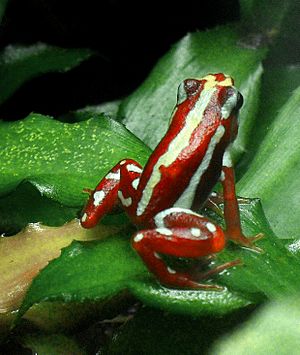Anthony's poison arrow frog facts for kids
Quick facts for kids Anthony's poison arrow frog |
|
|---|---|
 |
|
| Epipedobates anthonyi, in the Leipzig Botanical Garden, Germany |
|
| Conservation status | |
| Scientific classification | |
| Genus: |
Epipedobates
|
| Species: |
anthonyi
|
| Synonyms | |
|
Phyllobates anthonyi Noble, 1921 |
|
The Anthony's poison arrow frog (Epipedobates anthonyi) is a type of poison dart frog. It belongs to the family called Dendrobatidae. This frog lives only in Ecuador and Peru.
Contents
What's in a Name?
The frog's scientific name, anthonyi, honors an American scientist named Harold Elmer Anthony. He studied mammals and worked at the American Museum of Natural History.
What Does It Look Like?
Anthony's poison arrow frog is quite small. It measures about 19 to 26 millimeters (less than an inch) from its snout to its rear. Its back legs are short and strong. The frog's skin is usually dark red or brown. It has several yellowish-white stripes that go across its body. There is also a single stripe down the middle of its back.
Where Does It Live?
This frog has only been found in a few places. These are in southwestern Ecuador and northwestern Peru. It lives at different heights, from about 153 to 1769 meters (about 500 to 5,800 feet) above sea level.
Its Home
The Anthony's poison arrow frog naturally lives on the ground in tropical dry forests. It likes to hide among fallen leaves, especially close to streams.
Froggy Life
Anthony's poison arrow frog is active during the day. It spends its time on the ground. Male frogs protect their own areas from other males.
When it's time to lay eggs, the female lays 15 to 40 eggs on the ground. These eggs are hidden among the leaf litter. The male frog then guards the eggs until they hatch, which takes about two weeks. After the tadpoles hatch, the male carries them on his back. He takes them to a good water spot, like a small pond or puddle. There, the tadpoles grow and change into frogs in about sixty days. This change is called metamorphosis.
Scientists have studied a special substance found in this frog called Epibatidine. This substance is used for scientific research.
Its Future
The IUCN (International Union for Conservation of Nature) lists Anthony's poison arrow frog as "Near Threatened". This means it could become endangered in the future. The number of these frogs seems stable right now. However, they live in a small area, less than 20,000 square kilometers. Their home is being harmed by pollution from farm chemicals. People also collect these frogs, sometimes for traditional medicine.
See also
 In Spanish: Epipedobates anthonyi para niños
In Spanish: Epipedobates anthonyi para niños


